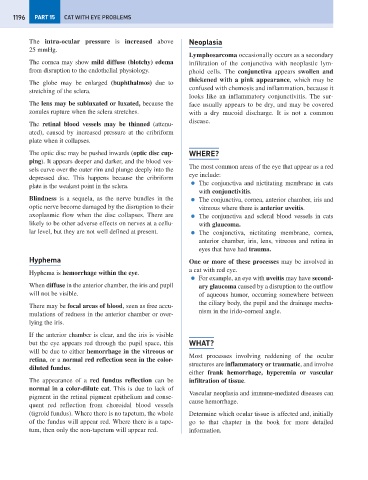Page 1204 - Problem-Based Feline Medicine
P. 1204
1196 PART 15 CAT WITH EYE PROBLEMS
The intra-ocular pressure is increased above Neoplasia
25 mmHg.
Lymphosarcoma occasionally occurs as a secondary
The cornea may show mild diffuse (blotchy) edema infiltration of the conjunctiva with neoplastic lym-
from disruption to the endothelial physiology. phoid cells. The conjunctiva appears swollen and
thickened with a pink appearance, which may be
The globe may be enlarged (buphthalmos) due to
confused with chemosis and inflammation, because it
stretching of the sclera.
looks like an inflammatory conjunctivitis. The sur-
The lens may be subluxated or luxated, because the face usually appears to be dry, and may be covered
zonules rupture when the sclera stretches. with a dry mucoid discharge. It is not a common
disease.
The retinal blood vessels may be thinned (attenu-
ated), caused by increased pressure at the cribriform
plate when it collapses.
The optic disc may be pushed inwards (optic disc cup- WHERE?
ping). It appears deeper and darker, and the blood ves-
The most common areas of the eye that appear as a red
sels curve over the outer rim and plunge deeply into the
eye include:
depressed disc. This happens because the cribriform
● The conjunctiva and nictitating membrane in cats
plate is the weakest point in the sclera.
with conjunctivitis.
Blindness is a sequela, as the nerve bundles in the ● The conjunctiva, cornea, anterior chamber, iris and
optic nerve become damaged by the disruption to their vitreous where there is anterior uveitis.
axoplasmic flow when the disc collapses. There are ● The conjunctiva and scleral blood vessels in cats
likely to be other adverse effects on nerves at a cellu- with glaucoma.
lar level, but they are not well defined at present. ● The conjunctiva, nictitating membrane, cornea,
anterior chamber, iris, lens, vitreous and retina in
eyes that have had trauma.
Hyphema One or more of these processes may be involved in
a cat with red eye.
Hyphema is hemorrhage within the eye.
● For example, an eye with uveitis may have second-
When diffuse in the anterior chamber, the iris and pupil ary glaucoma caused by a disruption to the outflow
will not be visible. of aqueous humor, occurring somewhere between
the ciliary body, the pupil and the drainage mecha-
There may be focal areas of blood, seen as free accu-
nism in the irido-corneal angle.
mulations of redness in the anterior chamber or over-
lying the iris.
If the anterior chamber is clear, and the iris is visible
but the eye appears red through the pupil space, this WHAT?
will be due to either hemorrhage in the vitreous or
Most processes involving reddening of the ocular
retina, or a normal red reflection seen in the color-
structures are inflammatory or traumatic, and involve
diluted fundus.
either frank hemorrhage, hyperemia or vascular
The appearance of a red fundus reflection can be infiltration of tissue.
normal in a color-dilute cat. This is due to lack of
Vascular neoplasia and immune-mediated diseases can
pigment in the retinal pigment epithelium and conse-
cause hemorrhage.
quent red reflection from choroidal blood vessels
(tigroid fundus). Where there is no tapetum, the whole Determine which ocular tissue is affected and, initially
of the fundus will appear red. Where there is a tape- go to that chapter in the book for more detailed
tum, then only the non-tapetum will appear red. information.

